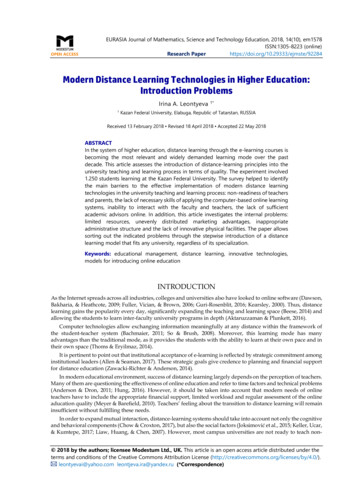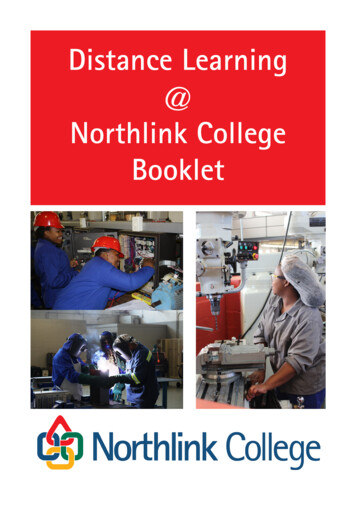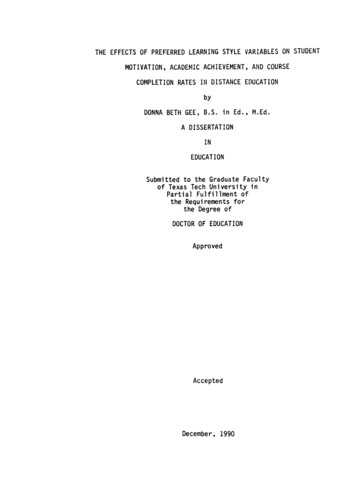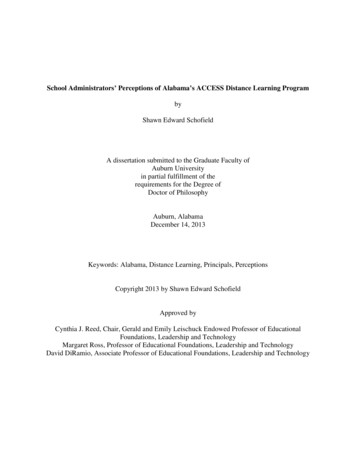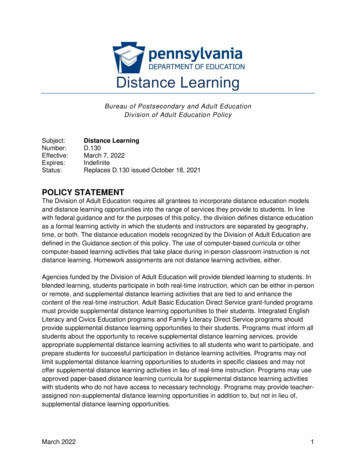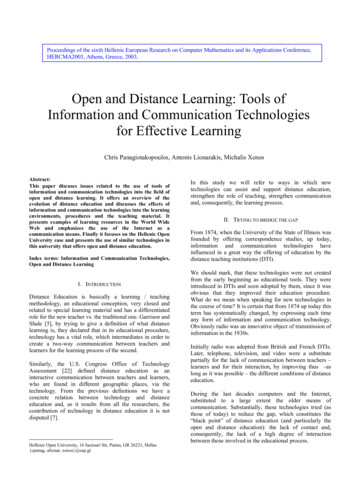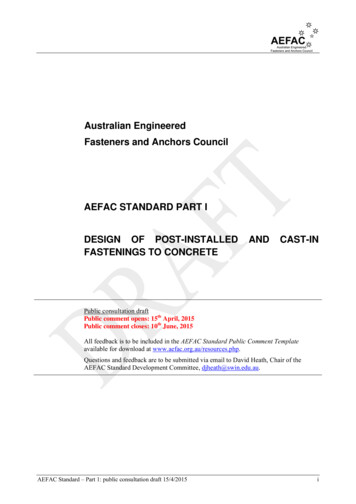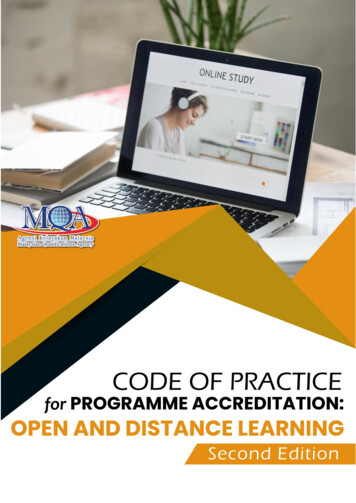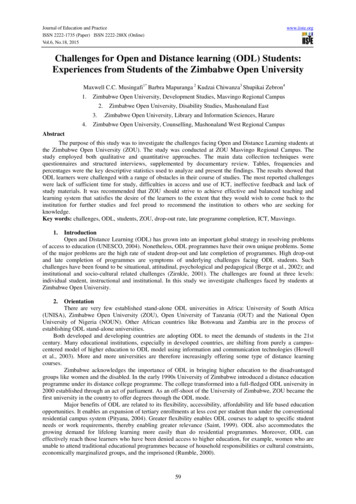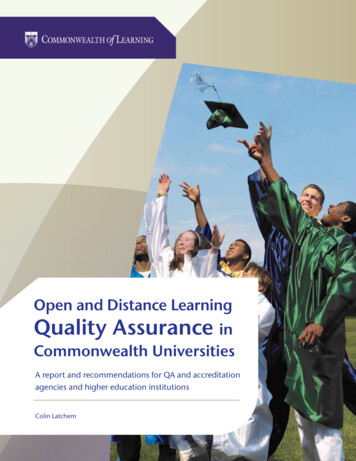
Transcription
Open and Distance LearningQuality Assurance inCommonwealth UniversitiesA report and recommendations for QA and accreditationagencies and higher education institutionsColin Latchem
Open and Distance LearningQuality Assurance inCommonwealth UniversitiesColin Latchem
The Commonwealth of Learning (COL) is an intergovernmental organisationcreated by Commonwealth Heads of Government to promote the developmentand sharing of open learning and distance education knowledge, resourcesand technologies.Commonwealth of Learning, 2016 2016 by the Commonwealth of Learning. Open and Distance LearningQuality Assurance in Commonwealth Universities is made available under aCreative Commons Attribution-ShareAlike 4.0 International 4.0.For the avoidance of doubt, by applying this licence the Commonwealth ofLearning does not waive any privileges or immunities from claims that theymay be entitled to assert, nor does the Commonwealth of Learning submititself to the jurisdiction, courts, legal processes or laws of any jurisdiction.Open and Distance Learning Quality Assurance in Commonwealth Universitiesby Colin LatchemOpen learning consultant, researcher and writer.ISBN 978-1-894975-79-7Published by:COMMONWEALTH OF LEARNING4710 Kingsway, Suite 2500Burnaby, British ColumbiaCanada V5H 4M2Telephone: 1 604 775 8200Fax: 1 604 775 8210Web: www.col.orgE-mail: info@col.orgAcknowledgementsThe author acknowledges the valued support and advice of Dr. Sanjaya Mishra,Education Specialist, eLearning, Dr. Godson Gatsha, Education Specialist,Higher Education, and Ms. Leticia Pamela Garcia, intern at the Commonwealthof Learning. The author is also grateful to Ms. Charisse Cruz, who providedsupport in conducting the survey, and to all of those in the various universitieswho took the time and trouble to respond to the questionnaire.The contributions of the editor, Dr. Dania Sheldon, and the designer,Ms. Ania Grygorczuk, are also appreciated.The Commonwealth of Learning is grateful to Dr. Ebba Ossiannilsson andDr. Stamenka Uvalić -Trumbić for serving as critical readers of the draft of thispublication and providing valuable comments.
ContentsForeword. 2PA R T 1: EXECUTIVE SUMMARY AND RECOMMENDATIONSBackground to the Study. 3Summary of the Findings. 3Recommendations. 4PA R T 2 : INTRODUCTIONAims of the Study. 5Methodology. 6ODL in the Universities of the Commonwealth. 7QA and ODL. 8PA R T 3 : FINDINGSNational QA and Accreditation Agencies and Frameworks.11QA Policies, Agencies and Frameworks.11QA of ODL and Face-to-face Provision.15Cross-border Provision.17ISO Certification. 18Institutional QA Policies and Practices. 20QA and Strategic Planning. 21Centralised and Decentralised QA Systems. 21Recognition and Reward. 23The Quality Cycle. 24Quality Culture. 25eLearning. 25Inputs- and Outcomes-based QA. 26External and Internal Auditing. 28Student Participation in QA. 29Cross-border Accreditation and Certification. 30Perceived Benefits, Outcomes, Constraints and Challenges in QA. 32Use of COL and Other Sources in QA. 34PA R T 4: CONCLUSIONS AND RECOMMENDATIONSSummary of the Findings. 36Discussion. 38Recommendations. 39References. 40A PPE N D I X I : ODL Key Terms and Definitions. 44A PPE N D I X I I : QA Key Terms and Definitions. 46A PPE N D I X I I I : The Survey Instrument. 48A PPE N D I X I V: International, National and Regional QA, Accreditationand Certification Organisations in the Commonwealth Countries. 53International Organisations. 53Regional Organisations. 53National Organisations. 55A PPE N D I X V: QA Standards and Guidelines for Open, Distance andOnline Learning. 60
FOREWORDContinuousimprovement inhigher educationinstitutions iscritical for theprovision ofquality educationthrough ODL in allits various forms.The issue of quality in open and distance learning (ODL) remains a majorconcern. Inadequate quality assurance (QA) measures, policies and systemsrender the credibility of ODL provision questionable. The Commonwealth ofLearning (COL) is at the forefront of promoting quality ODL and over the yearshas developed several toolkits, guidelines and monographs, as well as a microsite of web links on QA, to help Commonwealth countries benefit from credibleand qualitatively comparable ODL models. COL’s Review and ImprovementModel (COL RIM) has assisted at least 13 institutions with integrating QA intotheir systems and processes. As quality is a matter of continuous relevance,COL commissioned a study to investigate the state of QA in open highereducation institutions in the Commonwealth.This report offers some key insights and findings on how QA is currently beingpracticed in open universities in the Commonwealth, from the perspectivesof policy makers, leaders and practitioners in open and distance educationinstitutions. The lessons show that whilst the importance of QA is accepted asa strategic value by all, the standards of practice, criteria and measures differconsiderably. There is also a growing concern over QA in new forms of teachingand learning, including eLearning, open educational resources and massiveopen online courses.Continuous improvement in higher education institutions is critical for the provision of qualityeducation through ODL in all its various forms, including eLearning, online learning andblended flexible learning. When practitioners generate, innovate, adopt, adapt, repurpose and usesystems, learning resources and technologies, it is equally important to support the provision ofquality education through the ODL mode. Embracing continuous improvement entails havingrobust institutional QA policies, implementation strategies, and consistent monitoring, evaluationand reporting. It therefore calls for ongoing planning and implementation to achieve betterresults and the desired outcomes. Success is realised when higher education leaders, policymakers and practitioners walk the talk by embracing quality issues as part of their strategicdirection in their annual plans and daily practices at all levels within their institutions.We are grateful to Colin Latchem, a senior ODL professional with significant experienceand expertise in quality matters, for preparing this report. He has identified two sets ofrecommendations: (i) for governments and national QA agencies and (ii) for higher educationinstitutions offering ODL courses and programmes.I am sure that the report will be discussed and debated by the stakeholders in their respectivecontexts, and that the recommendations in this report will be considered starting points forreaffirming QA in ODL provisions.Professor Asha KanwarPresident and CEO of the Commonwealth of Learning2O P E N AND DI STANCE L E AR NI NG Q UALIT Y ASSU RAN C E IN C OM M ON WEALT H U N IVERSIT IES
The importance of quality assurancein open and distance learning iswidely understood; however, thereare countries and institutions whereprogress has been slower than mightbe expected and where policy makers,managers and practitioners are still inneed of advice and support.PART IExecutive Summary and RecommendationsBackground to the StudyThis study was commissioned by the Commonwealth of Learning (COL) to gain an up-to-dateoverview of the different policies, systems and practices in quality assurance (QA)1 in openand distance learning (ODL)2 in national QA and accreditation agencies and universities in theCommonwealth and, in light of the findings, make recommendations on QA standards andprocedures for policy makers and senior decision makers responsible for ODL at the national andinstitutional levels.Summary of the FindingsThe findings indicated that the general concepts of QA and recognition of the importance of QAin ODL are understood at both national and institutional level in most Commonwealth countries.However, there are countries and institutions where progress has been slower than might have12For definitions of key terms used in relation to QA, see Appendix II.For definitions of key terms used in relation to ODL, see Appendix I.O PE N AND DI STANCE L E ARN IN G QU ALIT Y ASSU RAN C E IN C OM M ON WEALT H U N IVERSIT IES3
been expected and where policy makers, managers and practitioners are still in need of adviceand support. In some cases, there may be compliance with QA processes but complacency overstandards. There are also signs that QA is not keeping up with the times in regard to newerforms of ODL, such as eLearning.RecommendationsGovernments and national QA and accreditation agencies should:1.Ensure that their QA and accreditation systems contain distinct standards, measuresor performance indicators for assuring quality in and accrediting ODL courses andprogrammes in all higher education institutions within their national jurisdictions, whetherpublic or private.2.Ensure that national QA frameworks contain distinct standards, measures or performanceindicators for assuring quality in and accrediting the ODL courses and programmes ofoverseas providers.3.Allow for a degree of institutional autonomy by co-developing QA frameworks for ODLwith the higher education community. These frameworks should set out the requirementsthat all providers are expected to meet and upon which they can draw to develop internalQA systems for their programmes and awards, according to their particular goals andcircumstances; these systems can then be audited for their effectiveness.4.Judge the quality of ODL and eLearning by the same generic measures as are usedfor conventional teaching and learning but augment these with criteria and measuresappropriate to the various modes and methods of delivery.5.Ensure that the QA and accreditation systems take due account of all of the newer forms ofeLearning, including the use of OER, MOOCs, and systems for providing open informal andnon-formal education and access to pathways to formal study.6.Judge quality in ODL provision on the basis of access, equity and diversity, as well as thetraditional measures for teaching, learning and research.7.Assess quality in ODL provision by measuring not only the inputs but also the outputs,outcomes and impact.8.Encourage and support student representation in all aspects of developing and applying QA.9.Provide competitive funding and other incentives to encourage high-performing andinnovative applications of ODL and QA in institutions and programmes.Higher education institutions should:41.Establish, maintain and update rigorous QA frameworks and benchmarking systems toassure quality in all forms of ODL and ensure accountability to their students and otherstakeholders, as well as continuous improvement in all of their operations.2.Establish QA centres or senior managers responsible for QA and benchmarking activities, inaccord with Recommendations 2–9 above.O P E N AND DI STANCE L E AR NI NG Q UALIT Y ASSU RAN C E IN C OM M ON WEALT H U N IVERSIT IES
For COL to continue to promote goodpractice and strengthen the credibilityof ODL as a means of delivery, it needsup-to-date data on how it can bestencourage and support national andinstitutional QA policy making andpractice in ODL.PART IIIntroductionAims of the StudyThe Commonwealth of Learning (COL) is an intergovernmental organisation created by theCommonwealth Heads of Government (CHOG) to encourage the development and sharing ofopen and distance learning (ODL) knowledge, resources and technologies.3COL is the world’s only intergovernmental organisation solely concerned with the promotion anddevelopment of ODL to improve access to quality education and training in all sectors.In regard to higher education, COL has been working with Commonwealth governments andinstitutions to develop national and institutional ODL policies, improve the quality of ODLsystems and enhance staff capacity to develop and deliver quality programmes.3For definitions of key terms used in relation to ODL, see Appendix I.O PE N AND DI STANCE L E ARN IN G QU ALIT Y ASSU RAN C E IN C OM M ON WEALT H U N IVERSIT IES5
For COL to continue to promote good practice and strengthen the credibility of ODL as a meansof delivery, it needs up-to-date data on how it can best encourage and support national andinstitutional QA policy making and practice in ODL.COL therefore commissioned this study to: gauge the extent, nature and status of quality assurance (QA) systems and practices4 in ODLin universities in the Commonwealth countries; document different systems and approaches to QA in ODL at the national and institutionallevels; examine the parity of ODL with conventional higher education in terms of QA, recognitionand accreditation; identify best practices and lessons learnt; and make recommendations for policy makers and senior decision makers to improve the qualityand status of ODL.The study was designed to investigate: national QA and accreditation frameworks; the management and administration of institutional QA systems; inputs- and outcomes-based QA; auditing; the accreditation and certification of institutions, programmes and courses; the accreditation and certification of cross-border provision;A 30-itemquestionnairewas sent to vicechancellors, deputyvice-chancellors,directors of qualitycentres and othersdeemed well placedto comment on thestate of QA in 100ODL institutions. cross-border provision; the use of external guidelines; and benefits, outcomes, constraints and challenges in applying QA.MethodologyA 30-item questionnaire was developed (see Appendix III), deriving from theliterature of QA in higher education. Following review and amendments by expertsin the field, the questionnaire, together with a letter from the President and CEO ofCOL, Professor Asha Kanwar, was sent to vice-chancellors, deputy vice-chancellors,directors of distance education, directors of quality centres and others deemed wellplaced to comment on the state of QA in 100 ODL institutions in developed anddeveloping Commonwealth countries.To strengthen its links with the various Commonwealth Member States, COL operates a networkof COL Focal Points nominated by ministers of education to be the primary contacts in thevarious countries. All of these Focal Points were also requested to forward the survey instrumentto institutions in their countries and invite them to provide data for this study.The study was conducted between 8 April and 31 July 2015. Thematic analysis was employedto identify, examine and record patterns or themes within the data. The report was structured46For definitions of key terms used in relation to QA, see Appendix II.O P E N AND DI STANCE L E AR NI NG Q UALIT Y ASSU RAN C E IN C OM M ON WEALT H U N IVERSIT IES
around these patterns or themes to provide an overview of developments in QA in ODL andreveal what more could be done to encourage and support national and institutional policies andsystems in assuring quality in ODL.ODL in the Universities of the CommonwealthMaslen (2012) reports that the number of students enrolled in higher education around the globeis forecast to more than double by 2025, to 262 million, and the number of students seeking tostudy abroad could rise to eight million — nearly three times more than today. Almost all of thisgrowth will be in the developing world, and a very large percentage of these students will beenrolled in the universities of the Commonwealth.Recognising the need to increase enrolments, developed and developingcountries alike have embarked on the “massification” of higher education. Theterm massification has traditionally been applied to making luxury productsavailable to the mass market. In the context of higher education, it describesthe practice of making education that was formerly available only to those withthe requisite entry scores, sufficient funds for study and convenient access tocampuses available to the less privileged, including remote, rural and poorurban communities, girls, women and minority groups. This is increasinglyaccomplished by adopting some form of ODL to improve access and equity andachieve more cost-effective provision.Recognising theneed to increaseenrolments,developed anddevelopingcountriesalike haveembarked on the“massification” ofhigher education.Some countries have responded to this challenge by establishing openuniversities, institutions which waive or exercise flexibility in formal entryrequirements. Examples include The Open University (UK), AthabascaUniversity (Canada), Indira Gandhi National Open University (India) and the Open Universityof Sri Lanka. Aiming for similar goals, Australia has taken a different approach, establishinga unique system called Open Universities Australia. This is a private company owned byseven of the country’s leading public universities that enables students without the traditionalacademic requirements to study online, follow learning pathways and, should they so wish,go on to study with and graduate from the leading Australian university of their choice withexactly the same qualifications as an on-campus student. All of the undergraduate and postgraduate qualifications available through OUA are Australian Qualifications Framework (AQF)qualifications.The Commonwealth can also claim to have some of the world’s largest universities by enrolment.These so-called “mega-universities” include Indira Gandhi National Open University — theworld’s largest university, with over four million students — Allama Iqbal Open University(Pakistan), with an average annual enrolment of more than 1.2 million, and Africa’s leading ODLinstitution, the University of South Africa, with an annual enrolment of over a third of a million.The Commonwealth also has two major regional universities: the University of the South Pacific,which has its main campus in Fiji and serves 12 Pacific Island nations, and the University of theWest Indies, with its main campus in Barbados, which serves the higher education needs of theEnglish-speaking countries and territories of the Caribbean.O PE N AND DI STANCE L E ARN IN G QU ALIT Y ASSU RAN C E IN C OM M ON WEALT H U N IVERSIT IES7
In developing and developed countries alike, there has also been an enormous growth in dualmode provision — that is to say, offering the courses leading to the same degrees both off and oncampus. There was a time when ODL and conventional higher education institutions could beseen as at the extremes of a continuum, the former characterised by the use of mediated deliveryand largely independent learning and the latter by face-to-face and teacher-supported study. Amix of technological, socio-economic and educational factors has now led to the convergence ofthese two delivery modes and the clientele of these two kinds of institutions. A wide range ofpublic and private institutions now deliver their programmes flexibly through a mix of print,audio, video, online and computer-based provision and face-to-face tuition. Both distance andcampus-based learners now have expectations of flexibility, increasedMobile learning learner-centredness, the ability to learn at times, paces and places of theirhas taken ODL a own choosing, self-tailored learning, greater choice in course offerings, peer,step further by collaborative and interactive learning, and a higher degree of standardisationallowing students in the quality and range of the course content and courseware. Mobileto learn virtually learning has taken ODL a step further by allowing students to learn virtuallyanywhere a mobile anywhere a mobile signal is available.signal is available.Institutions adopting these new educational paradigms set out their values instrategic plans and mandatory mission and vision statements, citing the needfor excellence (surpassing normal standards), access, equity, social justice,internationalism, efficiency and affordability. Whatever the ideals or political and commercialimperatives, all of these universities need to establish administrative and procedural activitiesto ensure that they fulfil all of the national, societal and institutional requirements and goals byensuring quality in their governance, policy making, planning, products, processes and services.QA and ODLFor all the evidence of improvements — in access and equity, more enriched and cost-effectivedelivery through applications of information and communication technologies (ICTs) and morepedagogically sound and learner-centred methods in ODL — governments, funding agenciesand the general public can still voice concerns regarding the quality of these newer forms of offcampus and on-campus provision. Sadly, there can also be unsubstantiated grandstanding andrhetoric in some of the claims made for ODL.Critics of ODL are only too ready to seize upon the lower or absence of entry standards, thelimited support for isolated learners, the costs and effort involved in creating and maintainingthe technological infrastructure and developing the courseware, and the sometimes higher noncompletion and failure rates. In some jurisdictions, ODL is perceived as “last-choice education.”Sometimes these viewpoints may be a hangover from the days of “correspondence education,”with its slow and poor-quality feedback and limited support for learners. In other cases, therise of private online providers more interested in profit than academic quality has helped giveODL a bad name. At the time of writing, criticisms of the quality of the learning experiencesand outcomes and poor job prospects for graduates of the University of Phoenix has left theUSA’s largest for-profit provider struggling with a decline in enrolments, from 460,000 studentsfive years ago to 213,000 today, and a drop of over 50 per cent in revenue (Gillespie, 2015).Having once regarded online and international students as “cash cows,” the for-profit education8O P E N AND DI STANCE L E AR NI NG Q UALIT Y ASSU RAN C E IN C OM M ON WEALT H U N IVERSIT IES
providers have failed to overcome criticisms of their quality and have become a sore spot in thedebate about the value of alternative forms of higher education.Some critics claim that ICT-based teaching and learning at a distance is impersonal and cannever be as effective as the face-to-face and experiential learning that on-campus study affords.Others argue that “less is more” and that the comprehensivisation of higher education and “cramthem-in” massification of the sector is downgrading the value ofdegrees in the eyes of the public and employers. There are alsoGovernments and otherconcerns about the costs and accountability of higher educationstakeholders around thein general. Whether for political or economic reasons, manyglobe are demandinggovernments are reducing their levels of funding support for publicmore evidence of studenthigher education whilst at the same time increasing their demands forparticipation, completionregulatory compliance. Governments and other stakeholders aroundand attainment rates, thethe globe are demanding more evidence of student participation,quality of the learningcompletion and attainment rates, the quality of the learningenvironments andenvironments and assessment procedures, the sector’s contributionsassessment procedures,to socio-economic development, and the quality of governance andthe sector’s contributionsstakeholder responsiveness in these areas.to socio-economicdevelopment, and the“Internationalism” has become a mantra in higher education, andquality of governanceuniversities across the world are being encouraged to reap the benefitsand stakeholderof global and technological interconnectedness. “Rankings” haveresponsiveness inbecome the new currency of quality. Stella and Gnanam (2004) havethese areas.observed that the rise of cross-border ODL prompts further concernsin governments and QA agencies across the globe regarding thesafeguarding of quality, integrity and sustainability in their national systems, and the protectionof students from worthless courses offered by dubious online providers.Accreditation andcertification areforms of QA thatguarantee a basiclevel of quality in theeducation provided byinstitutions and ensurethat degrees will berecognised for the trueachievements they are.Accreditation and certification are forms of QA that guarantee a basiclevel of quality in the education provided by institutions and ensurethat degrees will be recognised for the true achievements they are. Butnot all countries have yet established accreditation agencies to reviewtheir institutions of higher education and certify their quality. In mostcountries (the USA being one notable exception), accreditation for highereducation is conducted by government organisations. The drive forcompetitiveness is also leading some universities to seek certification fromthe International Standards Organisation (ISO).Brennan (1998) has summarised the reasons for QA and accreditation inhigher education: To ensure accountability for public funds To improve the quality of higher education provision To inform funding decisions To inform students and employers To stimulate competitiveness within and between organisationsO PE N AND DI STANCE L E ARN IN G QU ALIT Y ASSU RAN C E IN C OM M ON WEALT H U N IVERSIT IES9
To undertake a quality check on new (and sometimes private) institutions To assign institutional status To support the transfer of authority between the state and institutions To assist students’ mobility To make international comparisonsToday, as James et al. (2011) have observed, ODL is subject to laws, policies, rules, regulations andpractices imposed by government legislators, national and international QA and accreditationagencies, and professional and academic associations. Taxpayers, employers and student bodiesalso expect their concerns about educational standards to be addressed. At thesame time, it is generally accepted that university and academic autonomy mustIt is also recognisedas important that be maintained and that higher education institutions should be allowed to planQA not become for, maintain and evaluate their own academic standards in accord with theirtoo costly, diverse missions. In the UK, the Quality Assurance Agency (QAA) works closelybureaucratic and with the higher education sector to develop, maintain and update the Qualityburdensome upon Code; higher education providers use this code to help them set and maintain thethe universities. academic standards of their programmes and awards and assure and enhancethe quality of the learning opportunities they provide. It is also recognised asimportant that QA not become too costly, bureaucratic and burdensome upon theuniversities. However, when itcomes to ODL in higher education, there is clearly a need to ensure that extensive and rigorousQA systems are in operation, both internally and externally, if practitioners are to proveconclusively that their policies and practices are successful, beneficial and deployed consistentlyaround the world.10O P E N AND DI STANCE L E AR NI NG Q UALIT Y ASSU RAN C E IN C OM M ON WEALT H U N IVERSIT IES
The establishment, ownership,legal basis, governance, funding,degree of rigour and level ofindependence of QA agencies, aswell as the scope and characteristicsof their QA frameworks, vary fromcountry to country.PART IIIFindingsNational QA and Accreditation Agencies and FrameworksQA Policies, Agencies and FrameworksQuestion 2. Is there a national QA and accreditation framework for higher education inyour country?Qu
The Commonwealth of Learning (COL) is an intergovernmental organisation created by the Commonwealth Heads of Government (CHOG) to encourage the development and sharing of open and distance learning (ODL) knowledge, resources and technologies.3 COL is the world's only intergovernmental organisation solely concerned with the promotion and
